Around September each year, I'll start to look for Shagbark hickory nuts (common hickory or Carya ovata)-one of my favorite things to forage in the fall. They may be smaller than black walnuts and butternuts, but the flavor and versatility in how they can be used makes them more than worth the effort they take to gather.
In this post I'll share everything I've learned about them over the years: hunting, harvesting and processing, and a few of my favorite hickory nut recipes and uses
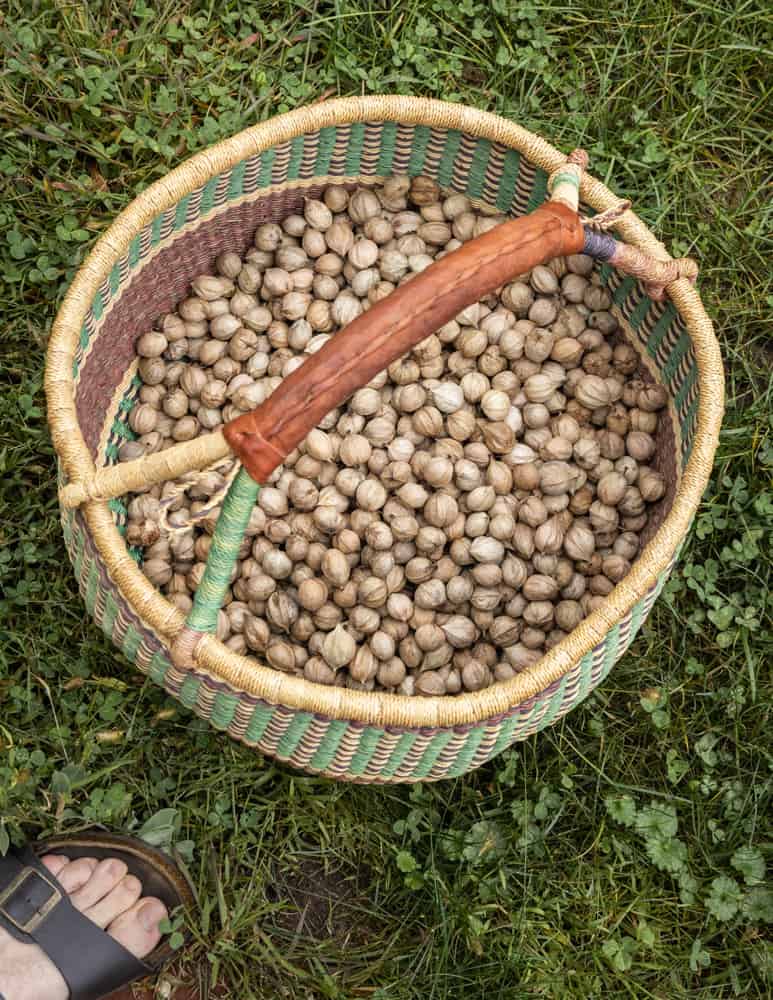
A Few Types of hickories
Hickories are related to pecans and are in the genus Carya. There's no poisonous hickory nuts and all are safe to eat, but bitternut hickory is unpalatably bitter.
There's a number of species in North America. Sam Thayer say about 11 depending on how the species are separated, other resources I've seen say as many as 18. Here's a quick list of a few varieties you might see brought up in conversation:
- Pignut Hickory (Carya glabra)
- Shellbark / King Nut (Carya laciniosa)
- Bitternut (Carya cordiformis)
- Black Hickory (Carya texana)
- Mockernut Hickory (Carya tomentosa)
For the purposes of this post, I'm only going to discuss shagbark hickories in depth, but as I have images of some of the others, I'm including them to help if you're new to these. For reference on size and shape between a few varieties see the picture below.
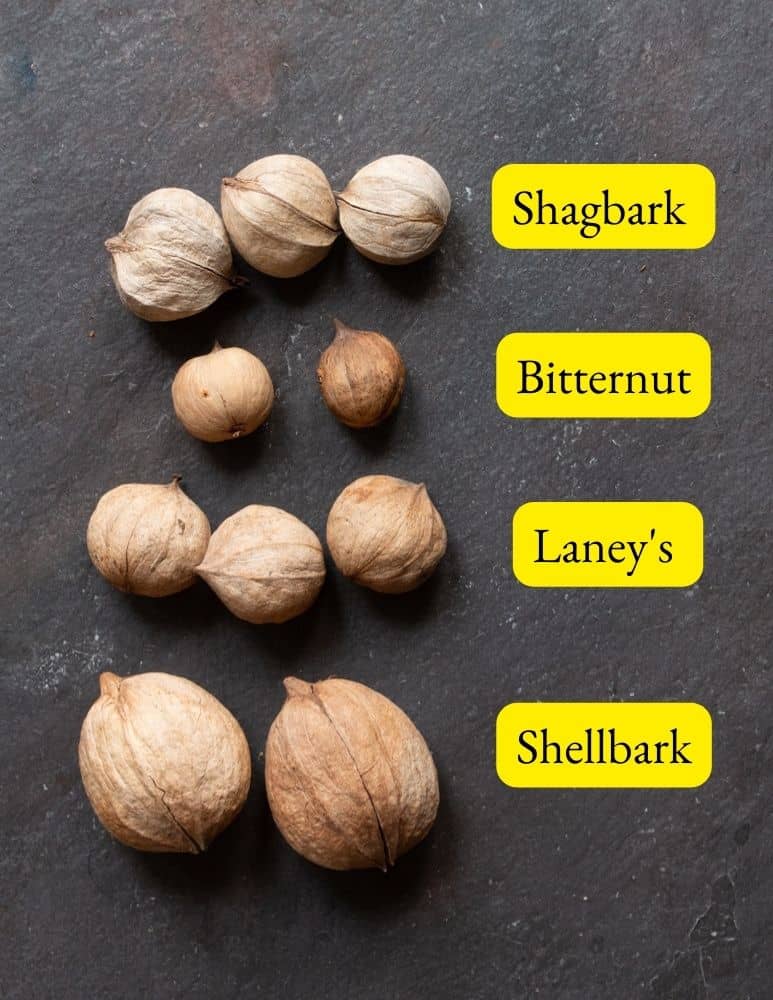
Other species I've had beside shagbarks typically have much thicker shells that make them more difficult to crack open.
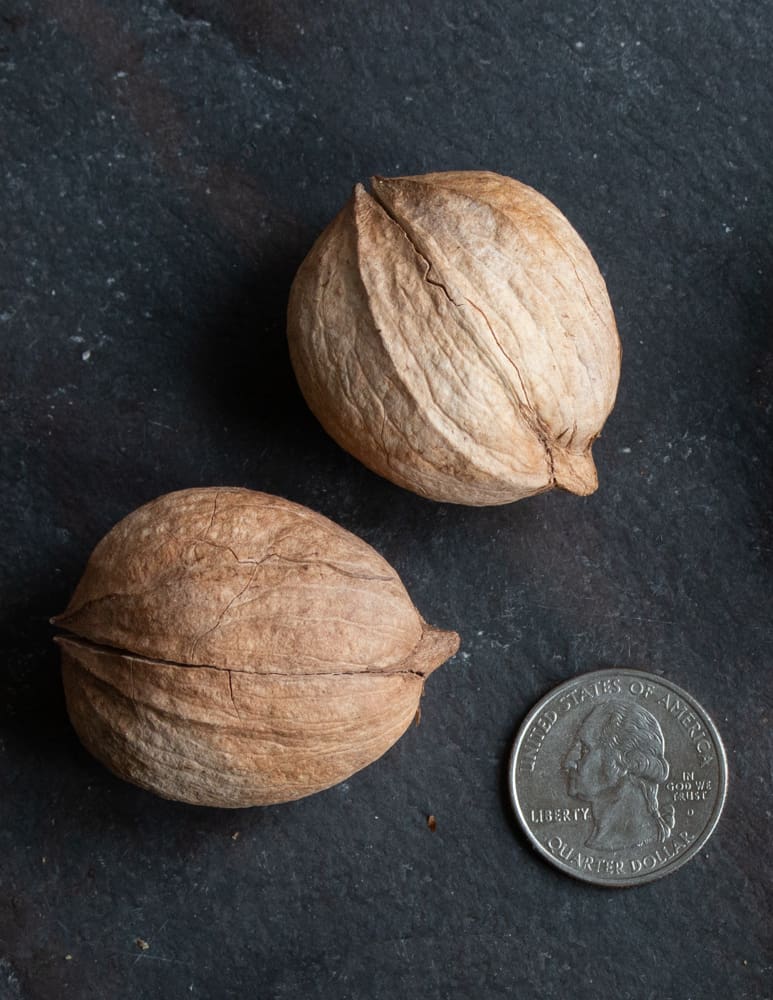
Bitternut hickory seeds are the exception as they have a thin shell, but the nut meats are bitter and only really good for pressing hickory oil.
Shagbarks have a thick husk and shell and taste good. Even so, newcomers often confuse the two, until they eat them.
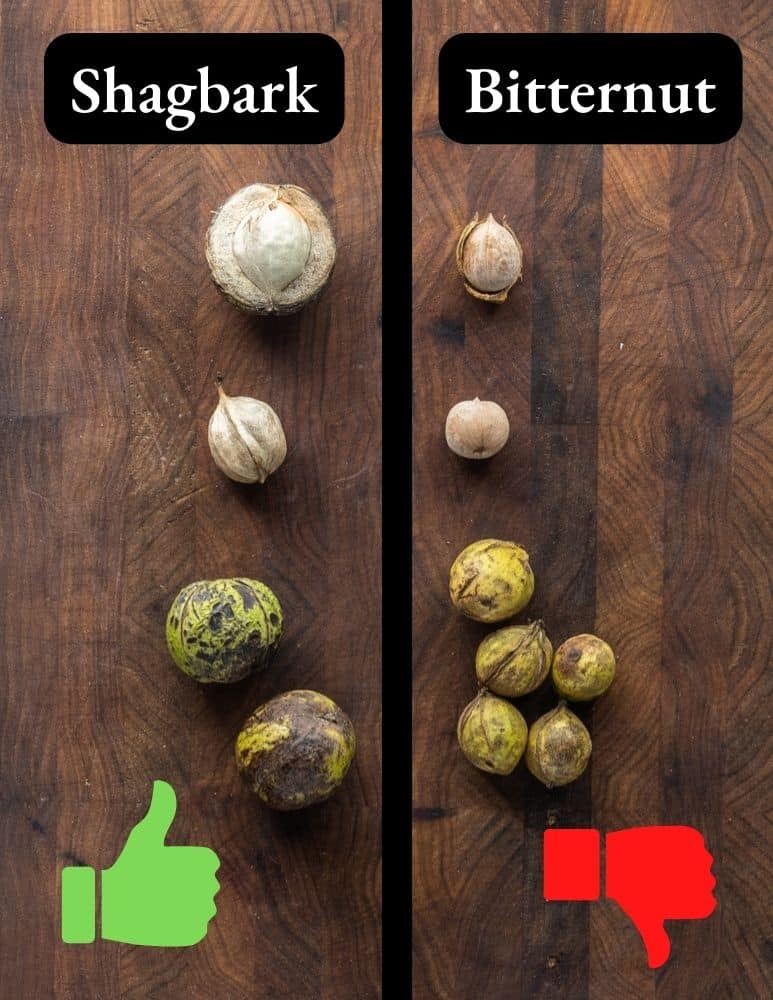
Special mention: Laney's Hickory: Carya lineyi
Possibly the ultimate hickory nut, Laney's hickory is a cross between a shagbark and a bitternut.
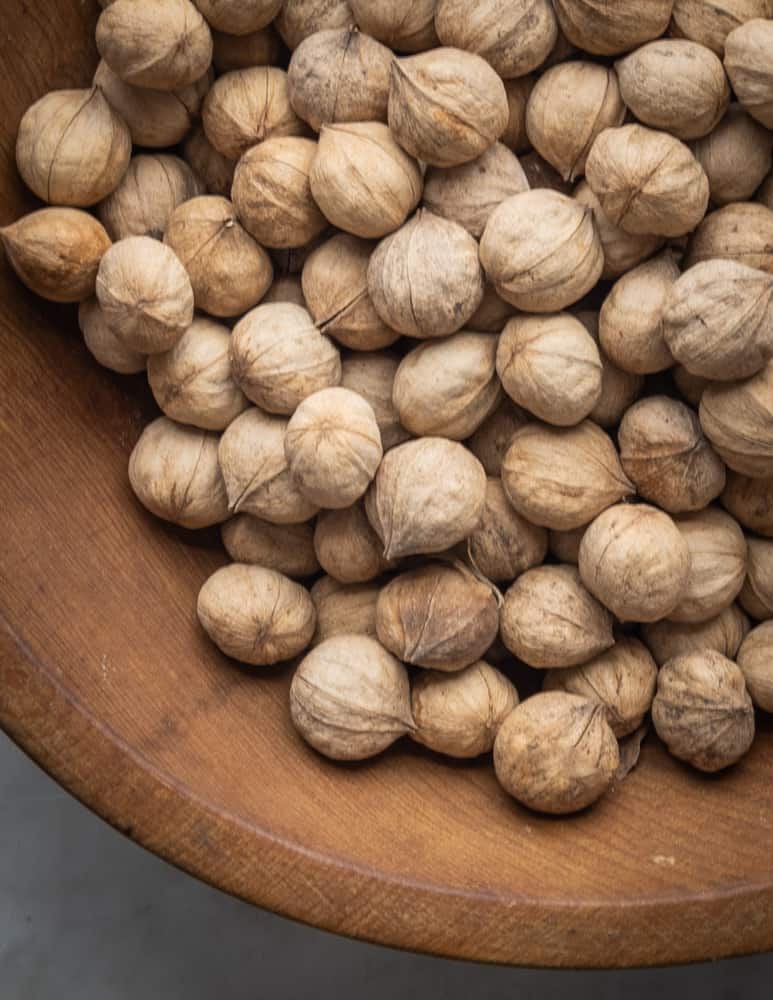
They have the thin shell of a bitternut hickory, but none of the bitterness. They're the best of both worlds. See the comparison below. Nature is fascinating!
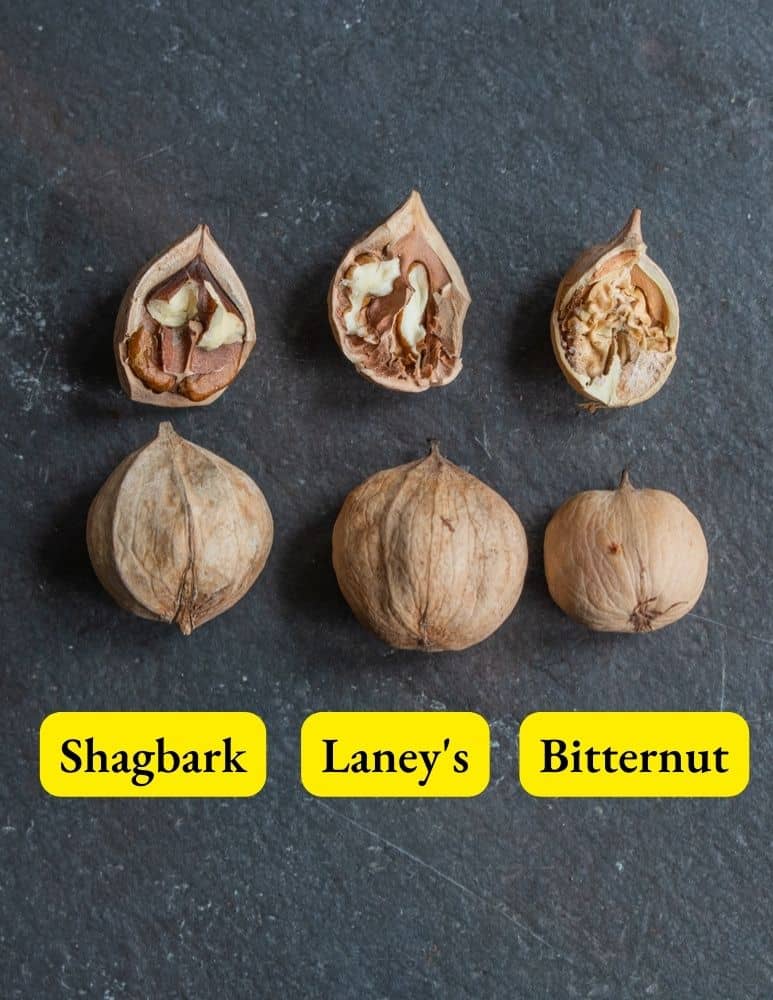
Identification
Shagbark hickory trees are one of the easiest trees to learn to identify. Here's a few quick tips.
- The bark is shaggy, covering the trunk in scales that are easily broken off. I find noticing the shaggy bark to be the easiest and fastest way to identify the trees in the woods.
- At a glance, their pinnately compound leaves resemble their cousins in the Juglandaceae (black walnuts and butternuts).
- Hickory trees are upright trees with a single trunk, and ones you want are typically large.
- In areas where they get good sun they can easily stick out, as in the picture below. In areas where I know they may be around, I may hunt them by car with a pair of binoculars.
- The leaves are darker green than many other trees.

Hunting
In order to get a good crop, you'll need to find a good patch of nut trees. To be very clear, I don't bother checking hickory trees in woods as the trees don't get as much sun, which means they won't make as many nuts.

Squirrels and deer also get nuts in the woods faster than in open areas. Ideally, you want trees that get lots of sun, and are in a relatively open space. A tree in a friend or relative's yard is ideal.
Here's two other things I may look for depending on the location:
1. Trees on the edge of the forest
Trees on the edges of woods can be great as squirrels will be less prone to take nuts in areas that leave them exposed to predators (like eagles and hawks).
2. Trees in logged areas
Trees in logged areas will get more sun, which means more energy for the tree, which means more nuts. Logged woods have been the best producing spots for me so far.
Scouting for masting trees
Hickory trees, like their cousins in the Juglandaceae (black walnuts and butternuts) have a variable rhythm in which they produce nuts called a masting cycle.
Some years trees may not seem to produce any nuts at all, some years there will be large amounts. Your job is to find trees that are masting, at the right place, at the right time.
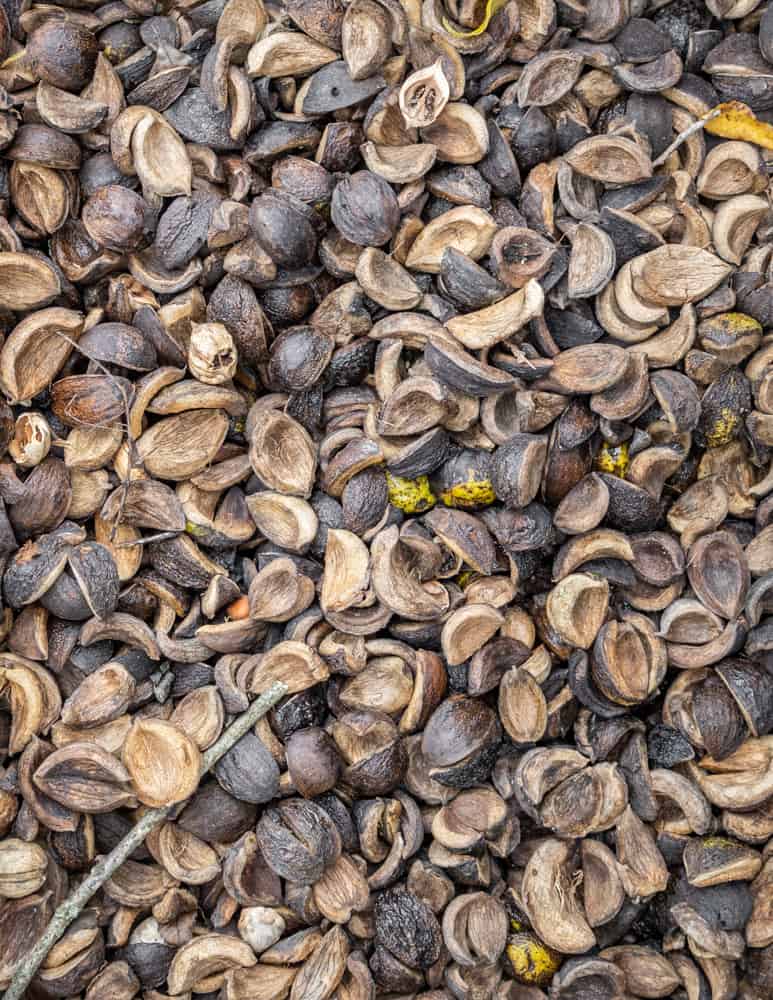
To hedge my bet, I often scout for nuts before they're ready to drop. I take a pair of binoculars and go to my patches, scanning the canopy of the trees for nuts which will appear as yellow-green orbs on the branches.
When I find trees that seem to have a good crop, I set a reminder to come back in a few weeks when the nuts begin to drop.
I harvest hickory nuts mid-to-late September through October where I live, although I've read they can start a month later in the south.
Harvesting
When I suspect the nuts are ready, I go to my patches I've scouted. In a perfect world I'll see freshly dropped nuts still in their green outer husk as I walk through the woods, and I'll probably hear nuts falling from trees all around me as I pick.
Unlike black walnuts and butternuts, hickories won't stain your hands when harvesting so there's no need to wear gloves.
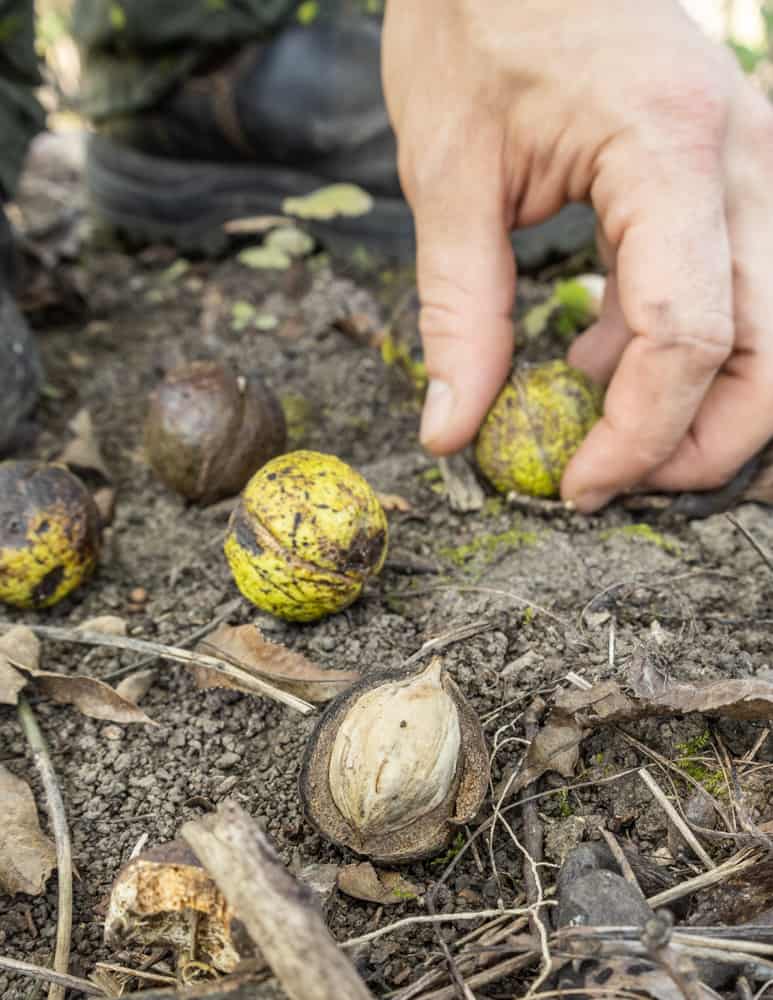
Avoid early nuts
Some nuts will fall early-avoid all of these. Trees may reject nuts for a number of reasons, typically the ones I see that fall early are nuts that have been aborted for some reason, or those that have insect damage.
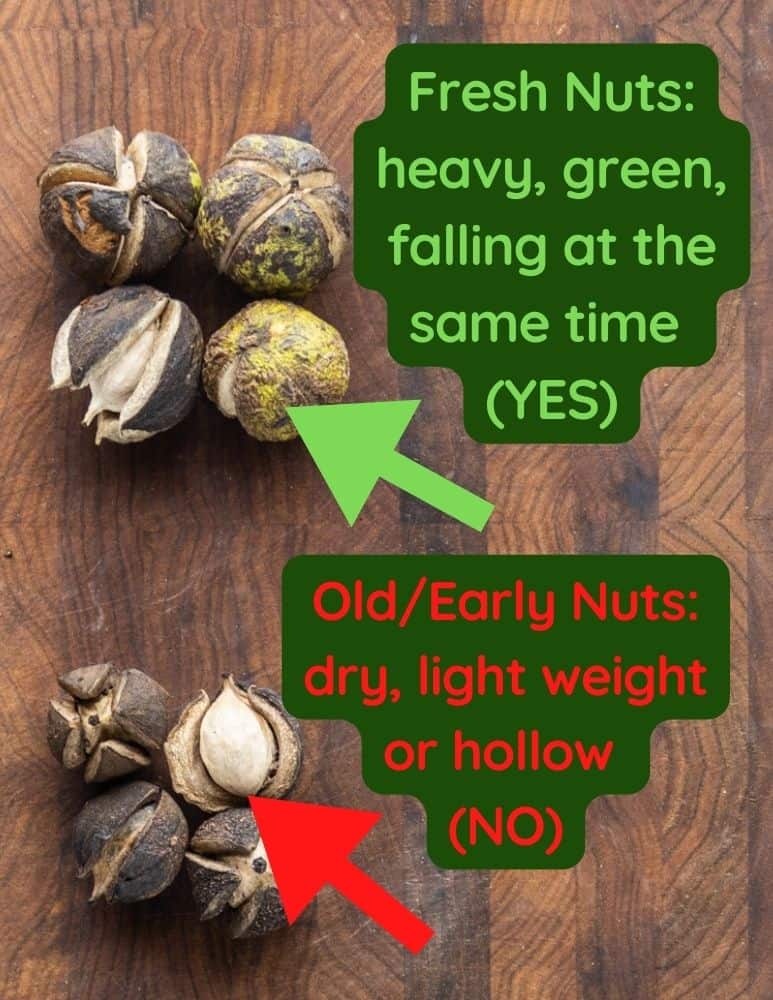
While you're harvesting, it can be tempting to pick up all the nuts you see, but you should resist the urge. Carefully inspect the nuts as you pick. Over time, you should be able to see the differences between freshly dropped nuts and those that may have dropped earlier and aren't good for eating.
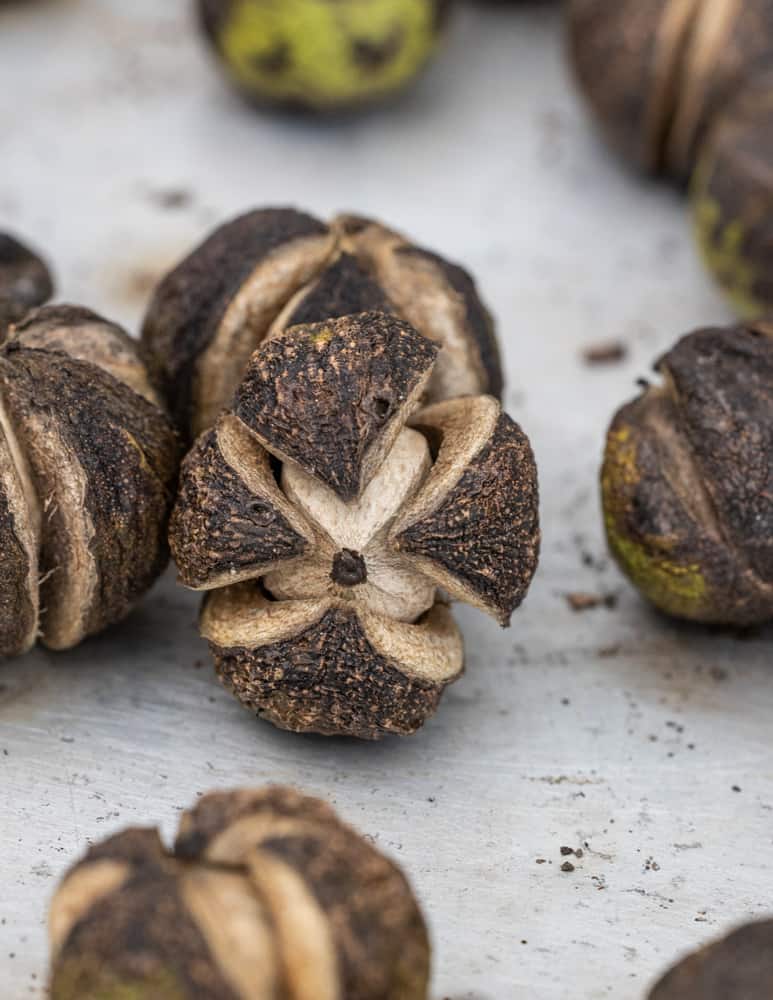
Look for healthy, living nuts
Wild hickory nuts are a living thing, and living nuts that could make a tree are the ones you want to eat. Look for nuts in a green husk that remove easily when handled. It's common for good nuts to fall out of the husk on the impact of hitting the ground, so grab those too.

One rule to always live by is to always avoid discolored nuts, any nuts with holes in them, or nuts that don't dislodge easily from their husk. If you pick everything you see you'll probably have to throw half of your harvest away.
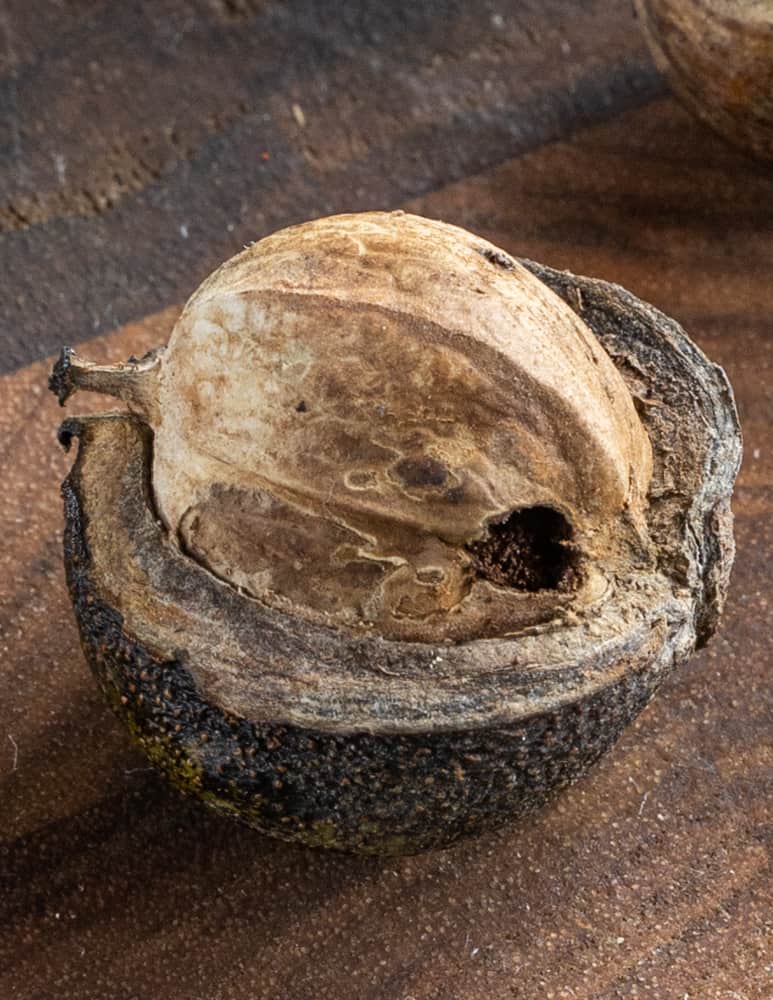
Floating
After the nuts are harvested, I bring them home and remove them from their outer husk. Some may be stuck in the husk-give them a quick dry overnight with a fan and they'll pop right out.
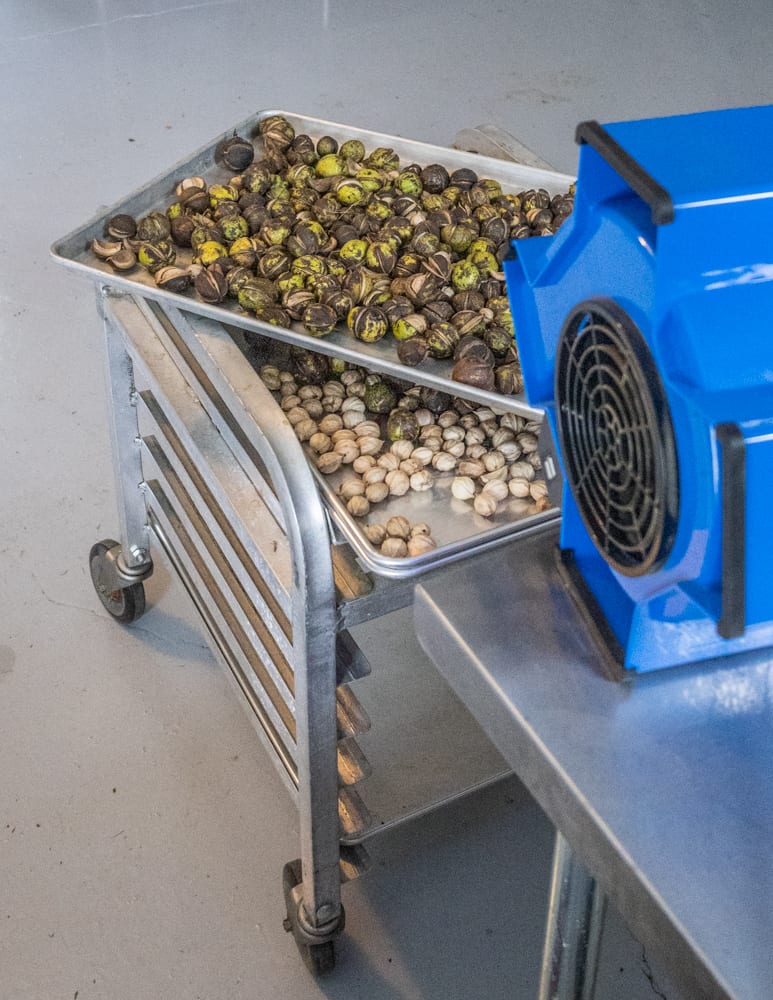
After all the nuts are removed from their husk, I will float them by putting a gallon of nuts in a bucket with about 4 gallons of water. Any nuts that float I will discard as they're probably compromised in some way.

It's important to understand that only fresh, and not dried nuts should be floated, as dried nuts will always float.
This can be confusing since some nuts can dry naturally on the ground as they wait to be harvested, which is another reason to try and get the nuts as they're falling at the same time from the tree.
Bugs
As you harvest avoid and discard any nuts that have holes in them, as that means bug damage and no nut inside. Hickory grubs (Curculio caryae) are the most common pest I see.
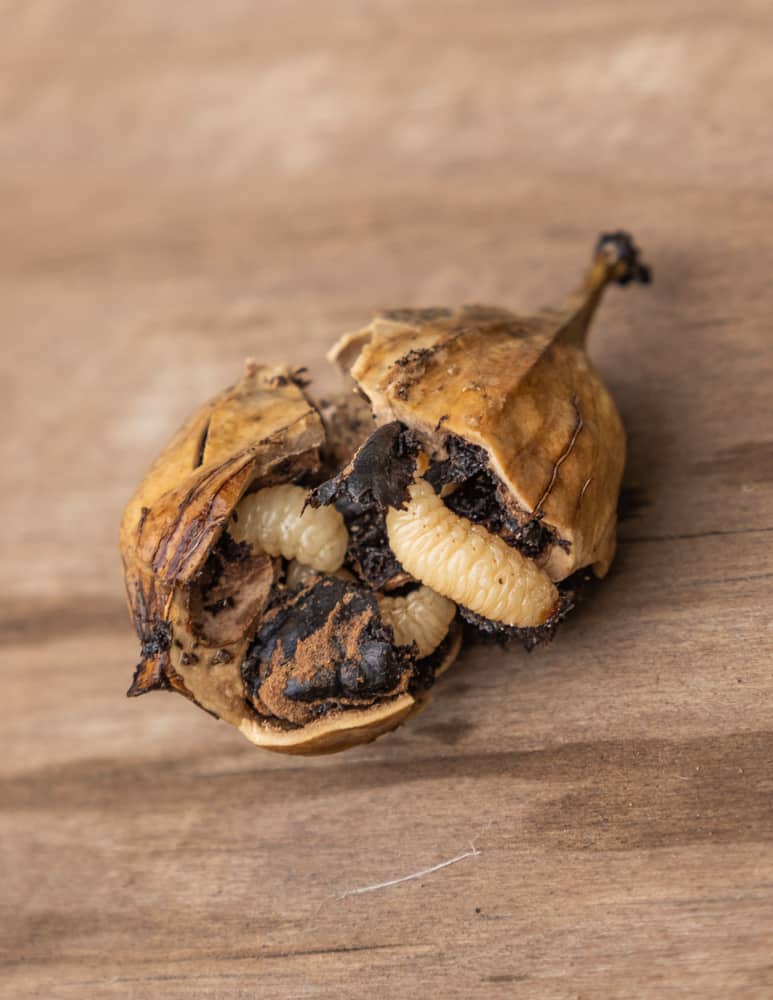
Bugs and pests can move through a harvest of hickory nuts if they're not processed quickly, so make sure to process your nuts quickly after harvesting to avoid loss. Once the nuts are dried and stored I've never had any issues.
Processing hickory nuts and storing
After the nuts are removed from their green husk, I set them out to dry on sheet trays in my garage with a fan blowing on them.
I find drying the nuts quickly helps to curb any bug damage, and is much faster than allowing the nuts to dry in a bag or gunny sack.
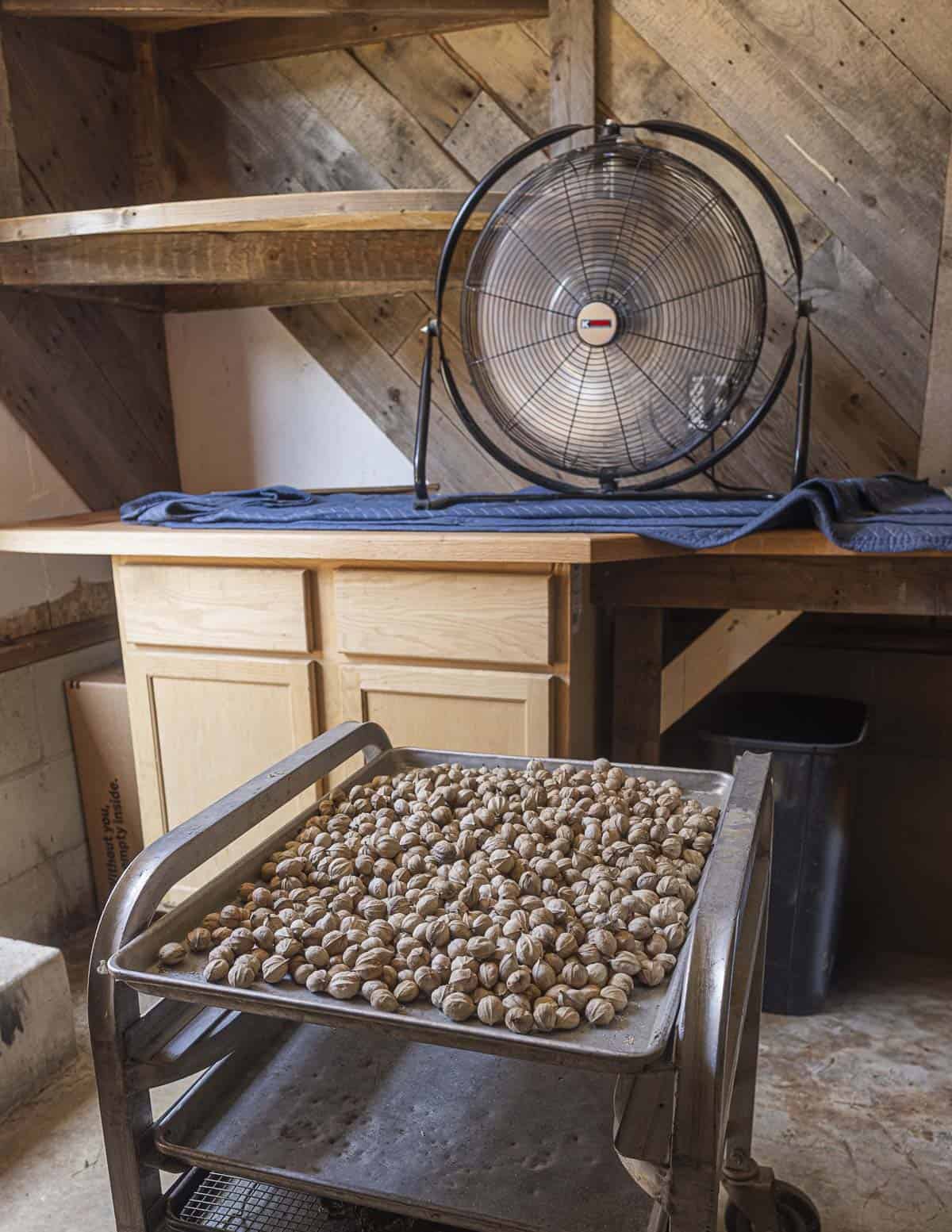
Using drying racks takes a little space, but if you harvest wild food it's a great setup for drying things quickly and efficiently, and that goes for any nut I harvest-not just shagbarks.
Freezing
Once the nuts are dry, which takes about a week, I put them in a bus tub and freeze them. From there they will last indefinitely and I pull them from the freezer to crack and process as needed.

Storing at room temperature
Unlike other nuts I harvest like black walnuts and acorns, dried hickory nuts can only be stored at room temperature for a few months-potentially longer if you have a cool dark place.
If you've stored hickory nuts at room temperature, crack them and they smell rancid, discard them as it only takes one to ruin a dish.

Cracking and shelling hickory nuts
Most shagbark hickory nuts I see are about an inch wide, but some are smaller. Whatever size you have, know that getting them to crack them open without crushing the nut meat is a learned skill.

Admittedly, I'm not very good at cracking them yet, but the Grandpa's Goody Getter nut-cracker has a hickory nut attachment some of my friends have used with good results.
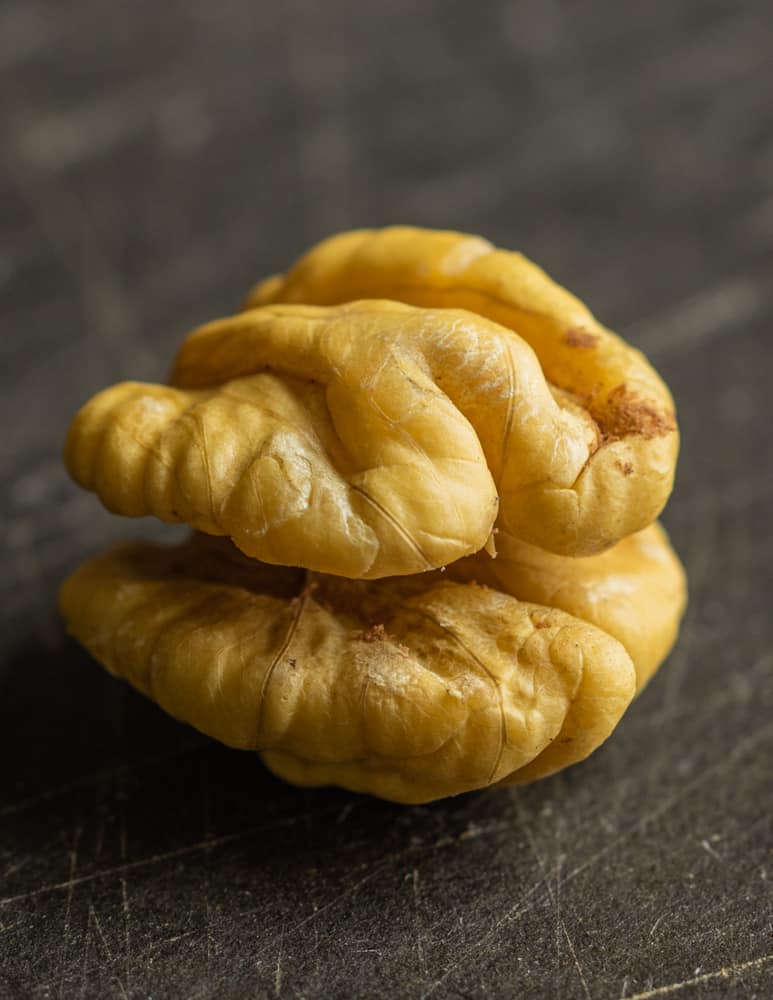
Getting the X
The old-school method Sam Thayer described to me for cracking hickory nuts involves striking the nut shell on the wide side in a way that makes an X. Using a hammer, put the nut on a flat surface and strike it lightly.
Ideally, there will be three or four fissures, which will make removing the nuts from the shell easier.
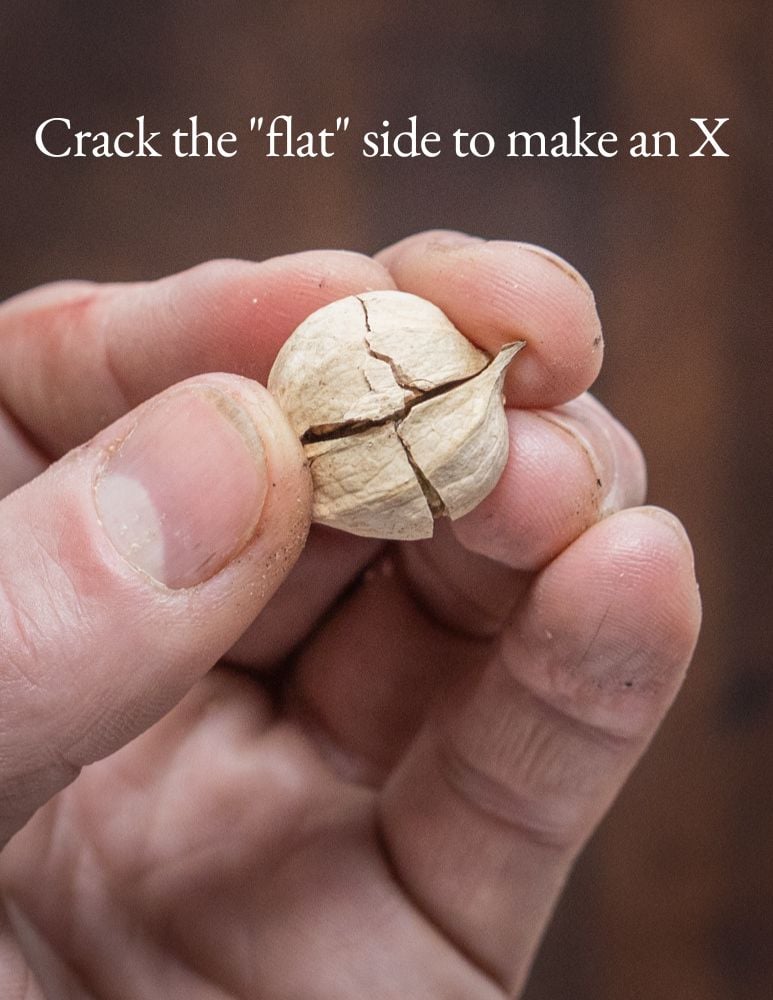
Using a nut pick and snips
If you want to crack them the old-school way, you'll also want a nut pick and a snips. Sam Thayer showed me how to make a homemade nut pick by flattening a nail and putting it into a piece of wood.
The thin, flat blade of the homemade nut pick is ideal for removing delicate meats from many wild nuts.
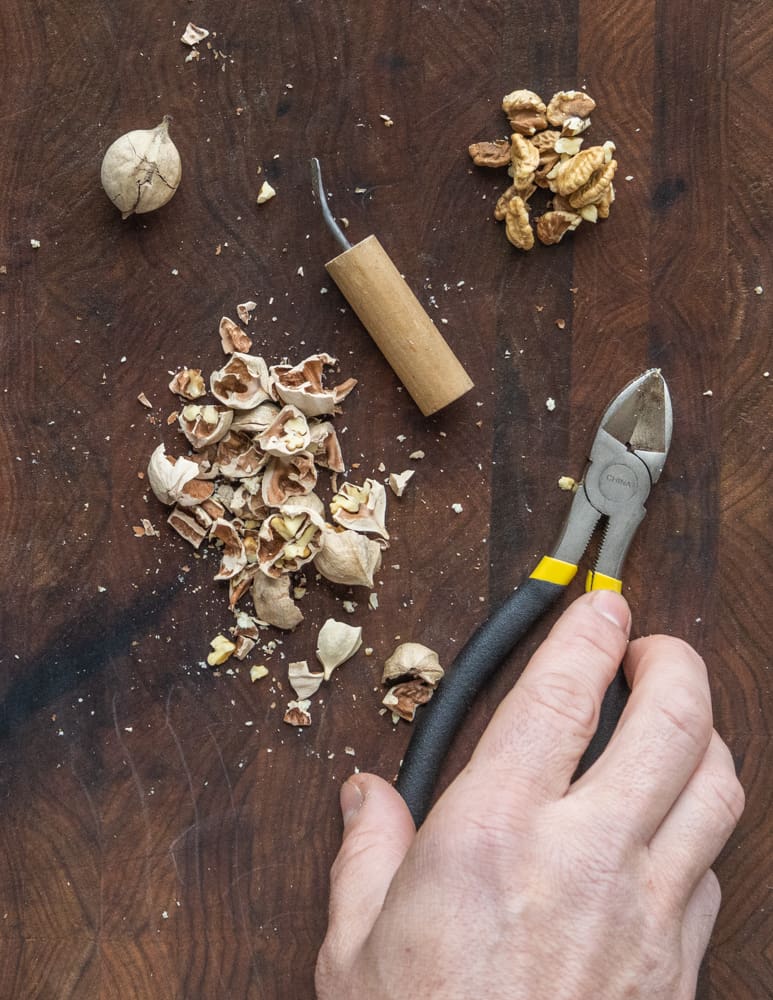


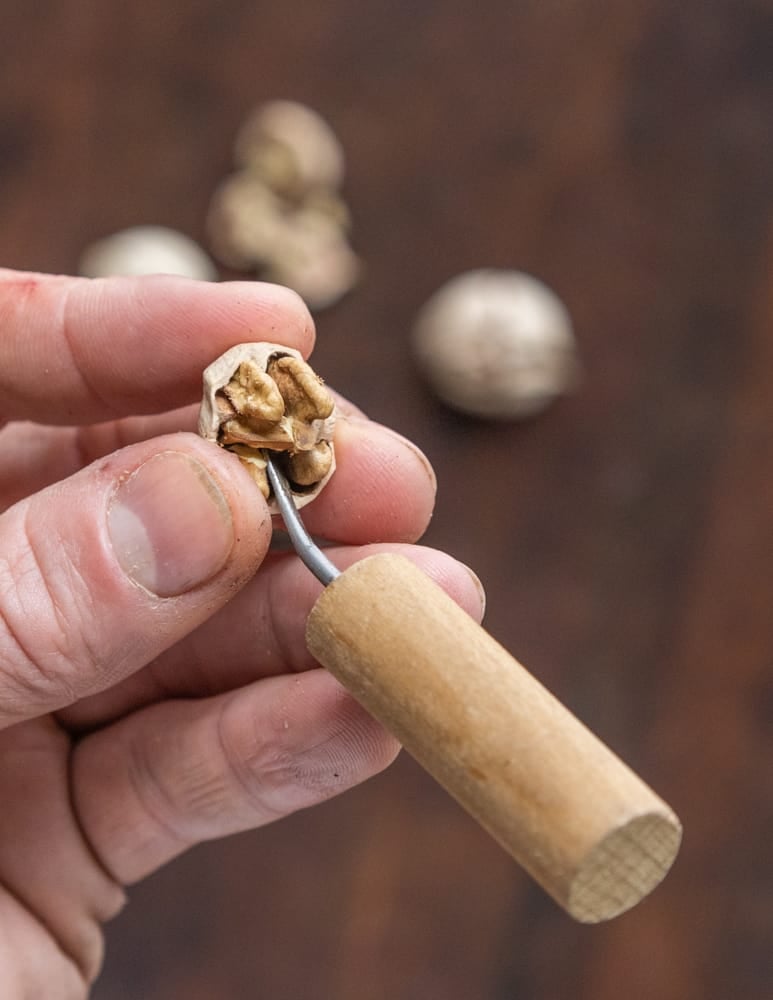
Cooking and Recipes for Hickory Nuts
When cracked and perfect, hickory nuts taste buttery and delicious like a pecan-never rancid, stale or musty. The nuts are edible raw, fresh from the shell and there's no need to toast them.
As they have a short shelf life, after shelling they should be stored in a fridge or freezer (a glass mason jar or bag is fine) if they won't be used right away. If I'm pulling shelled nuts from the freezer, I'll roast hickory nuts for 5 minutes at 350 F in a cast iron pan or cookie sheet. Be careful not to burn them.
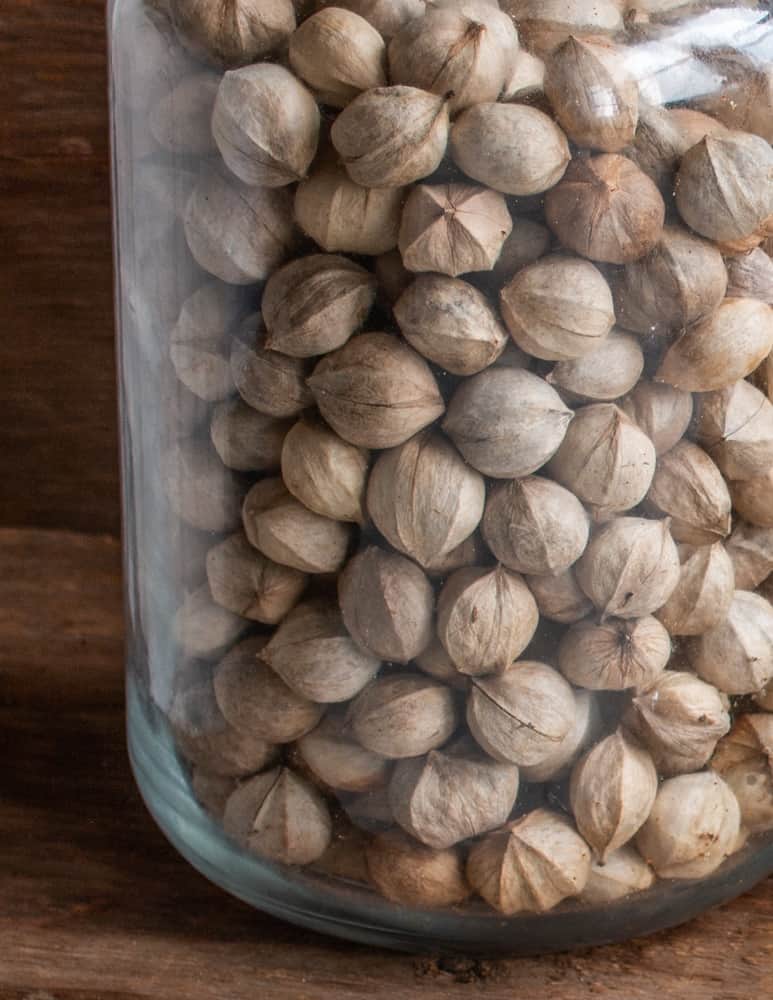
The cracked nuts can be used anywhere you'd use pecans. Hickory nut pie is a classic, but you'll need a couple cups of nuts. If you only have a few, they're great just eaten out of hand or sprinkled on a salad.

A few ways I use the finished nuts
- Lightly toasted and sprinkled on a salad
- As a garnish to desserts where you would use pecans
- In savory dishes, anywhere you would use pecans
- On top of your favorite breakfast cereal, like oatmeal
- In cookies, especially buttery shortbread (think pecan sandies)
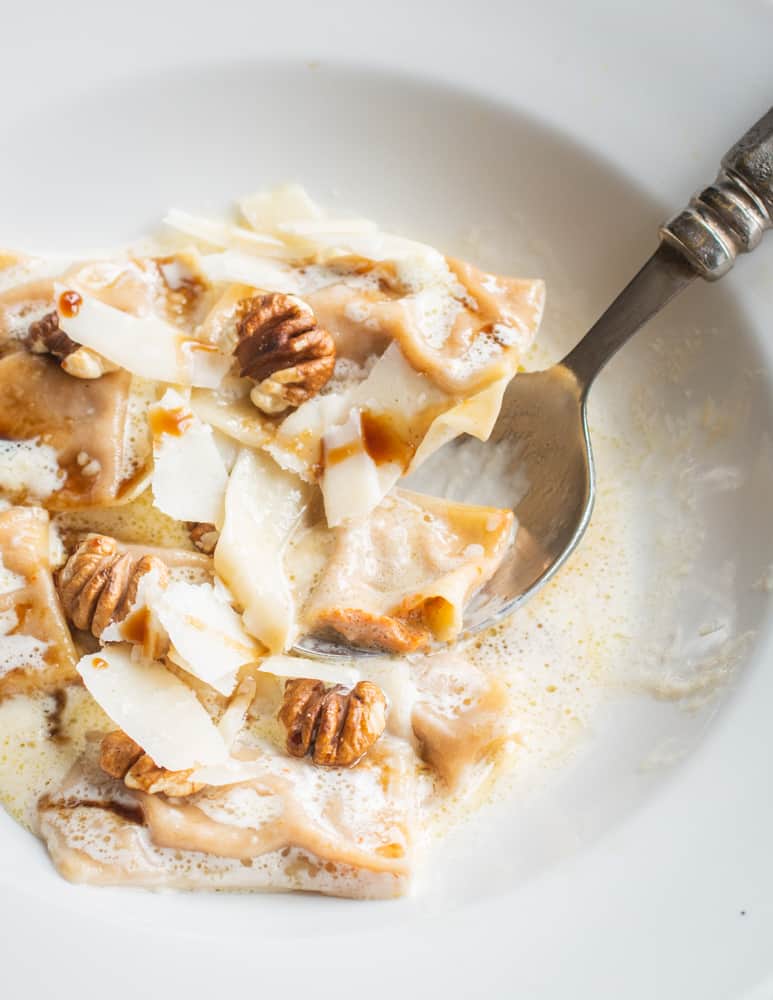
Kanuchi and Hickory Nut Milk
Kanuchi, an indigenous method of bashing the nuts, shell and all to a rough mash before simmering in water to make nut milk is the most ingenious method of processing hickory nuts I know of as you get to bypass the tedium of shelling the nuts. It's by far my favorite hickory nut recipe.
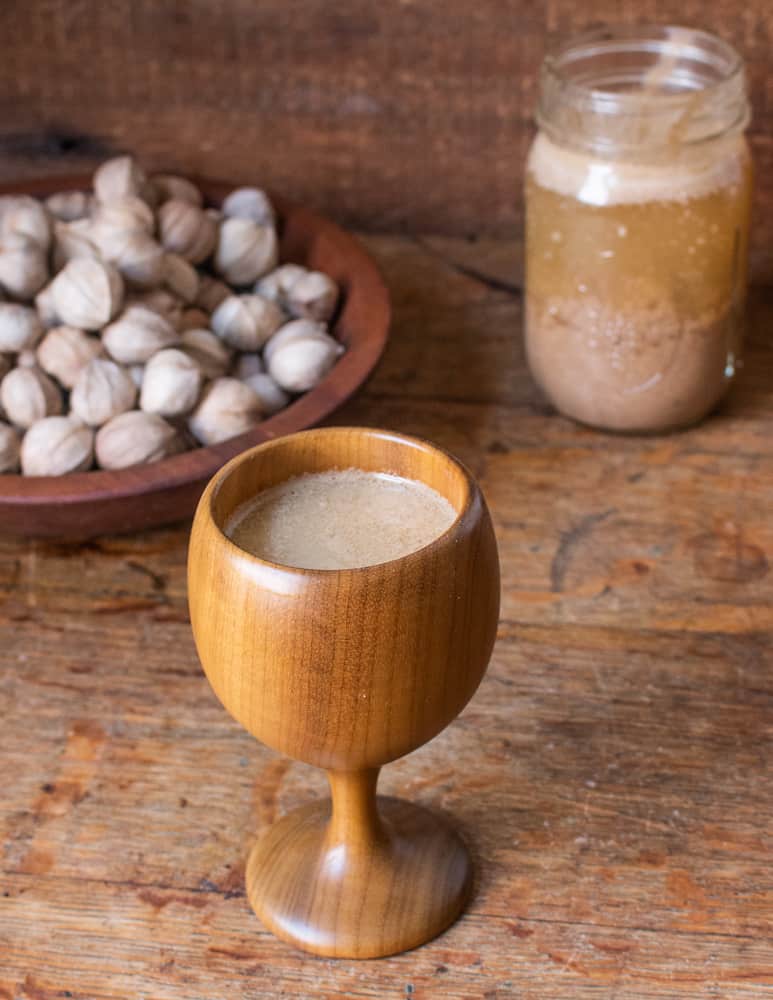
This is my go-to method for enjoying hickory nuts since I usually have other nuts to shell that are easier during the winter. For more on Kanuchi and traditional hickory milk see the link at the bottom of this post.
Shagbark Hickory Syrup
Besides the delicious nuts, shagbark hickory wood and bark is also used in cooking, typically for making hickory syrup or smoking.
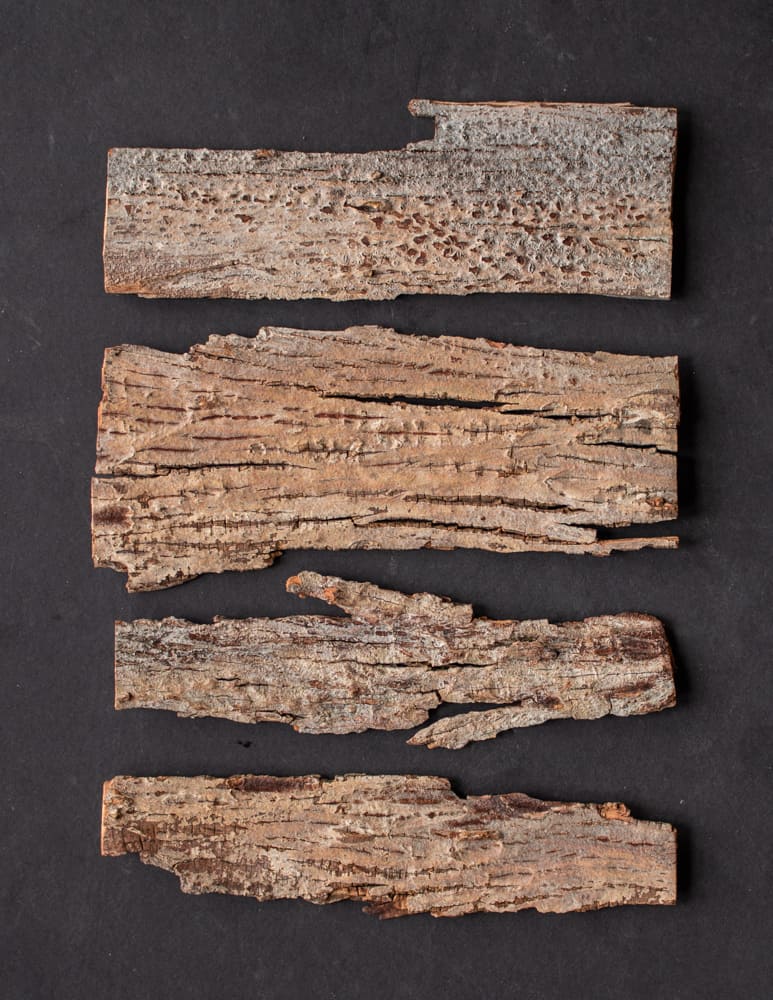
The syrup is so well liked by some people for it's smoky, hickory flavor that small farms and companies have started to sell it and you might even see it at farmers markets. Harvesting the bark is another thing to keep in mind if you visit your patches and don't find any nuts.
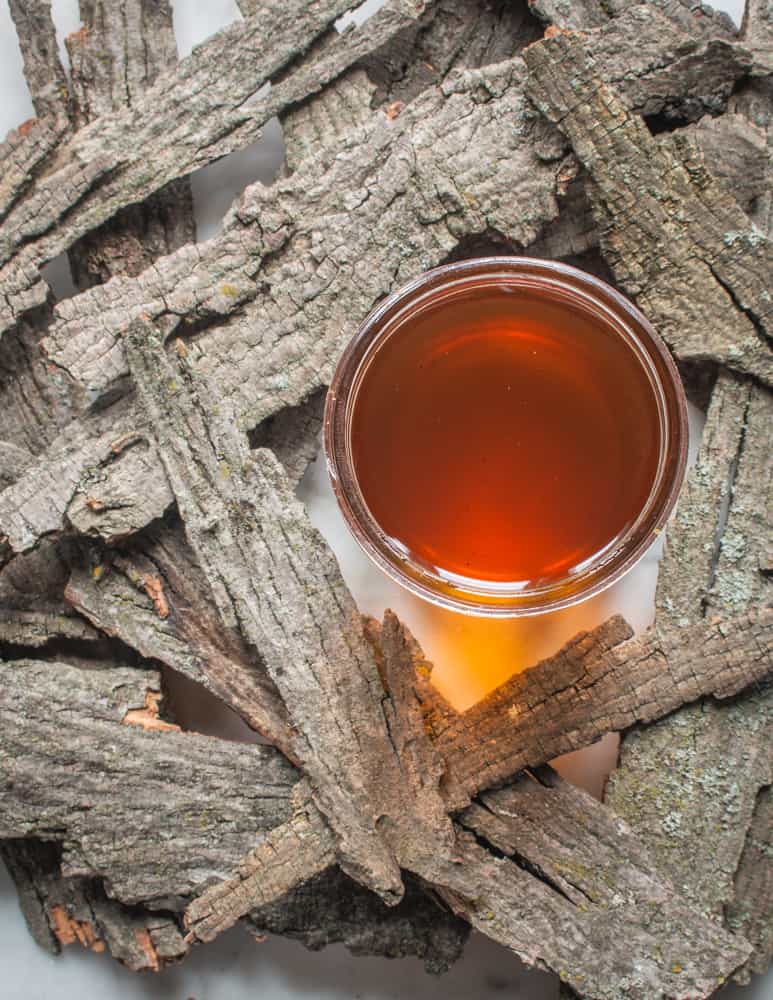
References
More
Recipes
- Wild Rice Cooked in Hickory Nut Milk
- Shagbark Hickory Milk Pot du Creme
- Shagbark Hickory Syrup
- Hickory Nut Rice Pudding
- Hickory Nut Tea
- Hickory Smoked Ice Cream
How to Harvest and Dry Shagbark Hickory Nuts
Equipment
- Large tubs or buckets for collecting nuts
- Sheet trays as needed
- 1 Fan for drying the nuts
Instructions
- Harvest shagbark hickory nuts that have fallen from the tree within the last few days.
- Bring the nuts home and remove the green husk. Some may be stuck in the husk, put those on a tray with a fan blowing on them in a garage overnight and they should remove.
- Submerge the fresh nuts in water and discard any that float.
- Set the nuts on trays out to dry with a fan on them for 2 weeks, then store in the freezer or in a cool dark place. If the nuts aren't frozen they will last 3-4 months.


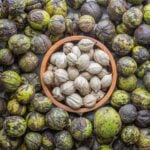
Charles
I noticed that you mention getting the shells out of the husks to see if they float in order to determine if they are viable. You mention that this must be done before drying them because if dried, they will all float.
But then soon after you show an image where you are drying the nuts in their husks on a rack, saying that they come out of their shells easier when dried.
So a little bit contradicting....
Alan Bergo
Hi Charles, the method I'm illustrating for harvesting nuts here is the same for all wild nuts. When you harvest nuts from the ground they will be fresh, but those damaged by insects are dead/inviable will float in water. After the nuts have been immersed in water so you can separate out the floating/bad nuts they're air dried. Air drying the nuts makes the nutmeat remove easier from the shell when cracking. There's a video in the post you can watch too, if that still seems confusing.
Barry
They're all commenting on your photo. You have them being dried by a fan while still in the husk. You would remove the husk, see if they float, then dry the nut. Your photo is skipping steps.
Alan Bergo
No it's not, but I can see why it might be confusing if you haven't harvested them. As I mention in the how-to card and under the image, some nuts may resist coming from the shell, a quick dry with a fan overnight will loosen them, then they can be floated. There's a video that describes the whole process too.
Jen
Thank you for the info! We have a few shagbark hickory trees in our yard. I’ve always been curious if we can harvest them. I’ll go for it this year!
Alan Bergo
Thanks Jen, they're such a good tree.
Carmen McD
Thanks so much for this info! I have a quick question on your step-by-step instructions. You mentioned floating the nuts right away, but you also said to dry them first. The photos show them in the green shell for drying, but obviously not in their green shell for floating. Which step is first? Do you actually dry them out of their green shell? Thanks!
Alan Bergo
Hello Carmen, so if that's unclear. I took a look at the how to and it reads very clear to me. If you read the recipe card it's all in there. You harvest the nuts, remove the green husk, float them, then dry.
Walter
At one of my former homesteads we had a few hickory trees the produced nuts almost on a regular basis and I would collect them to nibble on. Loved them until I moved and I missed them. 22 years ago my wife and I moved to our current location and noticed early on the squirrels had hickory nuts in their jaws. I often wondered where they were picking them up but never really thought much of it. After about 5 or so years living here I decided to build a nice big composter for yard and garden debris on the edge of the woods. Little did I know that I put the composter near a shagbark. It wasn't until I got bonked in the head did I realize I had a hickory tree very close by. It didn't produce much then but now it is hard hat area and I have harvested thousands of them over the last 3 years.
My way of cracking them open is to use a machinist vise. Crushing the nut slowly with the vises screw gives better control. I also found cracking them from each end rather than the side yields a good result as well.
Lastly, thank you for your web post. Very informative and exactly what I was searching for.
Alan Bergo
Thanks Walter
Susan C Madaus
Incredible hands on information. It is one of the best references I have found to learn more intricate details of how shagbark hickory nut might have been processed by Algonquin Native Americans in Massachusetts in the 1600s. It augments primary sources from that period that mention their use by the Indigenous people and has helped me to understand as I write about the use of the nut for a historical novel that takes place in that period. Thank you for the time and detail you put into this.
Alan Bergo
Hey Thanks Susan.
Alexandra Boyle
Hi Alan,
Thanks for all your great information! I happened upon hickory nuts the other day and have since been finding several different delicious types near me and am excited to use them! I wanted to ask you how you know when they are sufficiently dried. I have dried some in my dehydrator which caused some of them to split open, and some on screens in the attic (before we heard the sound of nuts rolling around during the night!). As I’m short on space, I’m wondering how to know when I can put them in jars and into the freezer. Thank you!!
Alan Bergo
Crack them open and try them. If the nuts are dry, they're ready to freeze. If they're soft at all, they need more time.
Carol Lawson
We had either a Shellbark or Laney's Hickory in our backyard as a child, and I almost cried when I found your article! So full of information and wonderful pictures! I had been trying to find out what it was so I could plant one in our yard. (Obviously I won't be harvesting those anytime soon!) Thank you so much for such an amazing article!
Alan Bergo
Carol I’m touched, that’s so nice of you to say. A lot of love and years of learning have gone into it. It would be very easy to tell a shellbark from a Laneys hickory. Shellbarks are very large with thick shells, I’d say 3-4 X the size of Laneys.
Tara
Thanks for the information! We bought a home a couple years ago and have a few of these trees on our property and I was just leaving them for the squirrels. I will have to start harvesting some and freeze them!
Alan Bergo
Great. I’m here if you have questions.
Mike O'Brien
Harvested quite a few shagbark hickory nuts this year. Not so many squirrels around to compete with. Couple of questions, I shelled enough this afternoon to produce about a cup of meats. Can they be used in a nut bread in place of walnuts?
What is the best way to freeze shelled nutmeats? Do the nutmeats release from the shell easier if they get drier?
Thanks.
Mike O'Brien
Alan Bergo
Hey Mike! A cup of hickory nuts is a good amount. They will always be difficult to remove from the shell compared to say, black walnuts. You can use them anywhere you’d use other nuts.
Gennifer
This is great deep end of the pool information for my family! We discovered Shagbark Hickory nuts while hiking through 2020 when there wasn't much to do, and we fell in love with them. They are a bear to shell though, so we're definitely going to look at getting some more tools.
I just found your article because our family now has a farm that has tons of hickory trees on it and this will be the first fall we don't have to go hiking to find the nuts. Thank you so much for all of these details and even the extra fun recipes!
Alan Bergo
Thanks Gennifer. Glad it was helpful.
John M Jones
The Grubs can also be used as bait. Supposed to be popular with ice fishermen I suppose they refridgerate them.
I use a 7 CR visegrip (crescent shaped as for a pipe) to crack them then the wirecutters you get a lot of halves.
apply on the side edges photo link on flickr for demo https://flickr.com/photos/rentavet/37595018906
The readjusting for size does add time.
Alan Bergo
Thanks for sharing John!
John Paul
Really great info here. The point about finding trees on the edge of a wood area was something I never thought of before, but is so obvious now that you mention it.
Question - When I float the nuts, I always discard the ones that are obviously floating (like to the surface of the water). But I'll also have some that aren't fully resting on the bottom. They are touching the bottom ever-so-slightly (like a hickory nut pirouette). Would you throw those out or keep them?
Alan Bergo
Hey John, I'd keep them.
Christine Talbot
I want to buy shagbark nuts.
Janet Hayman
Thanks for all this info! I now know that I have both a shagbark hickory and a bitternut hickory growing right next to each other in my front yard, both fruiting prolifically this year. I have some shagbark nuts drying now and I’m excited to try them.
Alan Bergo
That's great.
Don Blackert
Thanks Alan. Very comprehensive. I have a lot of shag and shell bark trees, and have SLOWLY learned most of what you covered here in one fell swoop. The only add I would have is that, if you only have a small quantity, try them sprinkled over vanilla ice cream.
One question - What's wrong with shell bark hickory nuts?
Alan Bergo
Hey Don, thanks. I love them on ice cream. Just put 5 lbs in apple crisp for 200 people two days ago too for the Midwest Wild Harvest Festival. Nothing wrong with shell barks at all, they just take up a lot more space than hickories. Since I keep them in my freezer it isn't economical, I also don't have them near me. The shells are like steel too, and shagbarks are going to be much more approachable for people learning about them. If you have them though, feel free to send me cracked nuts meats all you want!
Katy
Are the hickory nuts that are falling now from the chipmunks chewing them off the trees good to save? Or is it too early to harvest them? So many are chewed up right now. This just started in the last two weeks
Alan Bergo
Too early right now.
Tim Tedeschi
Thank you for another amazing post!
Along with the wild Black Walnuts and one Butternut tree (as well as oaks, sugar maple, etc), I have Shagbark and Pignuts on my property. My problem is that every year I've tried to gather them, they virtually all have bugs and worms in them.
Are the trees diseased (permanently), or do you think there's something I can do to save these nuts? I gather black walnuts with almost none of the bugs or worms. When I was little and we'd go mushroom hunting with my dad, my mother would ALWAYS gather bushels of nice, healthy Hickory nuts. Do you think it's just my trees that are bad? They're way too tall to spray the canopy.
Alan Bergo
You can have some hickory grubs sometimes. I never get them in black walnuts or butternuts. One thing you can do, as I mention in the post is to float the nuts and discard floaters. The best advice I have is to make sure you are harvesting them as soon as possible when they hit the ground, and that the nuts are then dried and frozen ASAP.
Kristen
Can you dry nuts in the sun? Rather than with a fan/indoors?
Alan Bergo
Sure. As long as they get dry and are sheltered from rain.
Adriana
Thanks for all the great information. I have a shag bark hickory in the back yard of the house I just bought. I can't wait to harvest some nuts this fall.
Alan Bergo
Oh you're so lucky. I have to travel an hour as I'm a little north of their range.
Rene Ehrhardt
Thank you so much for the wealth of information! I just found you today! I have 40 acres with many shag bark hickory trees. I will say that when scouting for them, I would also favor the ones growing along a stream as all the ones growing beside the stream have fatter nuts. I can't wait till the nuts start dropping this year so that I can try your recipes!
Alan Bergo
Thanks Rene.